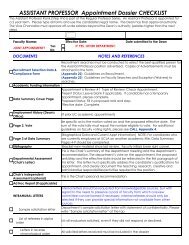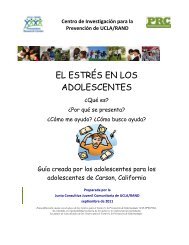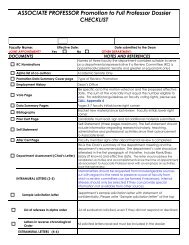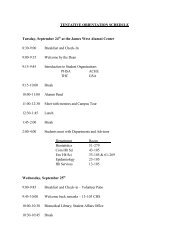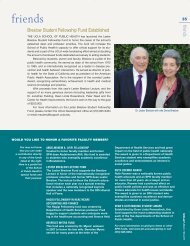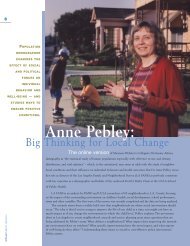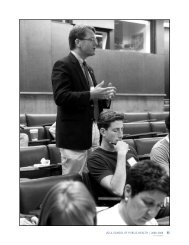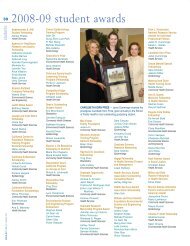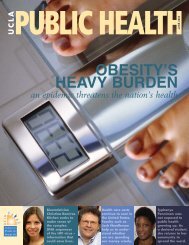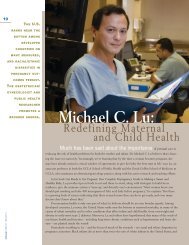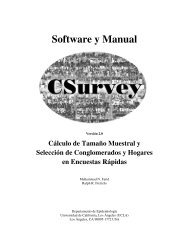JUNE 2001 - UCLA School of Public Health
JUNE 2001 - UCLA School of Public Health
JUNE 2001 - UCLA School of Public Health
You also want an ePaper? Increase the reach of your titles
YUMPU automatically turns print PDFs into web optimized ePapers that Google loves.
alumni pr<strong>of</strong>ile<br />
Heal the Bay’s Mark Gold Uses “Impact Science”<br />
to Clear the Murky Waters Off <strong>of</strong> Santa Monica<br />
MARK GOLD (D.Env ’94) REMEMBERS THE LECTURE like it was yesterday —<br />
even though it took place nearly 15 years ago, while Gold was taking courses<br />
toward his doctorate in the <strong>UCLA</strong> <strong>School</strong> <strong>of</strong> <strong>Public</strong> <strong>Health</strong>’s Environmental<br />
Science and Engineering (ESE) Program.<br />
“It was a talk given by someone from the California Department <strong>of</strong> <strong>Health</strong><br />
Services,” Gold recalls. “He said, ‘If you in academia don’t make recommendations<br />
on technical issues, just remember, elected <strong>of</strong>ficials will. If you stay in that<br />
ivory tower, those multi-million dollar decisions that impact public<br />
health are going to be made without you.’ ”<br />
The statement reaffirmed what Gold had concluded while<br />
getting his master’s degree in biology at <strong>UCLA</strong>. “I decided I was<br />
a big-picture kind <strong>of</strong> guy, and that, rather than pure science, I<br />
wanted to do something that was going to make a difference in<br />
protecting the environment,” he says.<br />
He found his calling in 1986, shortly after entering the policyoriented<br />
ESE Program. Gold was in a class in which one <strong>of</strong> the<br />
guest speakers was Dorothy Green, who had just founded a nonpr<strong>of</strong>it<br />
organization <strong>of</strong> volunteers concerned about coastal pollution<br />
in Santa Monica, where Gold had been raised. Gold began<br />
volunteering at Heal the Bay. Two years later, he was hired as the<br />
organization’s first employee, in the position <strong>of</strong> Staff Scientist.<br />
Since 1994, he has served as Executive Director.<br />
Heal the Bay was formed at a time when the Santa Monica Bay<br />
was, in Gold’s words, “a mess.” Pollution from sewage and storm<br />
drains was causing reproductive problems and tumors in fish, and a<br />
large section <strong>of</strong> the bay had become essentially lifeless. Sewage<br />
spills were shutting down the bay with regularity. An alarming number<br />
<strong>of</strong> surfers and swimmers were complaining <strong>of</strong> stomach flu,<br />
sinusitis, and other illnesses. Meanwhile, Gold had heard too many<br />
politicians use the lack <strong>of</strong> sound science on a given issue as an<br />
excuse not to protect the environment and public health. He vowed<br />
to fight back with data. Gold calls it “impact science” — timely<br />
research designed to assist decision-makers in acting in the public<br />
interest. “I think our use <strong>of</strong> science to educate the public and advocate<br />
on issues is what sets us apart from most groups,” he says.<br />
Today, Gold says, the Santa Monica Bay is in much better shape than when<br />
Heal the Bay began its efforts. Gold estimates that there has been a 90% reduction<br />
in sewage solids discharged to the bay since the mid-1980s, restoring plant<br />
and animal life to previous “dead” zones. Among its successes, Heal the Bay coauthored<br />
legislation setting the first statewide bathing water standards, along<br />
with a protocol for health warnings and beach closures.<br />
He’s quick to point out that there’s still work to be done, particularly in reducing<br />
storm water pollution, where little reduction has occurred despite Heal the Bay’s<br />
best efforts to push for tougher regulations. “The combination <strong>of</strong> inertia and dischargers’<br />
refusal to do what’s necessary to protect water quality is continually frustrating,”<br />
Gold says. “People just hate to change.” But by harnessing the persuasive<br />
powers <strong>of</strong> its 10,000 members and 500 volunteers, Heal the Bay has already<br />
effected more change than could have been predicted. Gold, who is assisted by two<br />
staff scientists who are doing their dissertations through the ESE Program, says his<br />
D.Env. has been a key to his success. “It gives you the diversity <strong>of</strong> skills necessary<br />
to tackle complicated problems,” he says. “That’s critical, because environmental<br />
issues are a great deal more complex than a lot <strong>of</strong> other research issues.”<br />
“I think our use <strong>of</strong><br />
science to educate<br />
the public and advocate<br />
on issues is what<br />
sets us apart<br />
from most groups.”<br />
21<br />
alumni <strong>UCLA</strong>PUBLIC HEALTH



